Te Whare Taonga ki Kawatea
Mar 27, 2020

In 1849 when Ngāi Tahu rangatira were negotiating the purchase of the ‘Port Levy Block’ with Crown agent Walter Mantell, they requested, but were refused, a reserve at Kawatea, Okains Bay. Famed in tribal history as a landing place of the migrational waka, Makawhiu, the name ‘Kawatea’ is associated with the small bay to the east of the main beach of what is commonly known as Ōkeina or Okains Bay. This traditional link is apt, given the prominent role that waka-paddling has played in the bay for the past 45 years. Kaituhi Helen Brown reports.
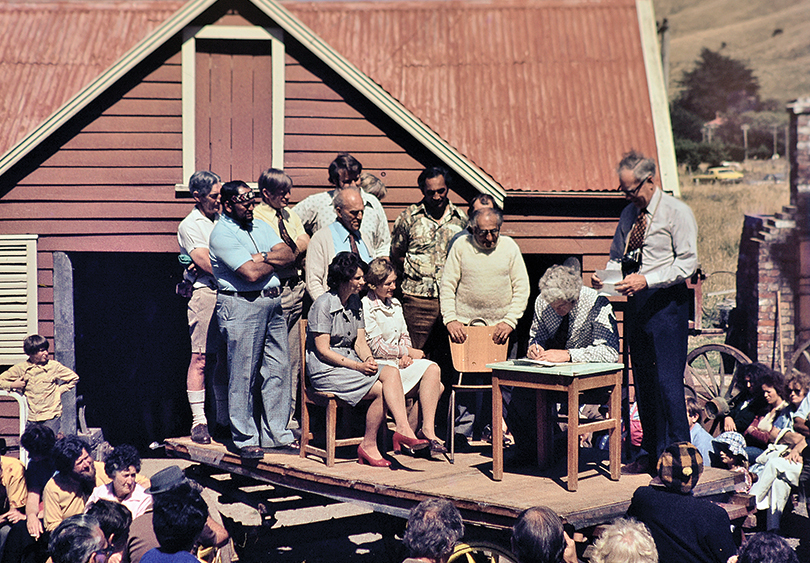
Above: Opening of the Okains Bay Māori and Colonial Museum, Waitangi Day 1977; Murray Thacker signing the Museum Trust deed and Francie Robinson at front, far left.
When Kōtukumairangi was paddled down the Ōpara River on Waitangi Day this year it marked 20 years since the waka had been formally gifted to Ngāi Tahu by the late Murray Thacker (1933-2017), founder of the Okains Bay Māori and Colonial Museum. Craig Pauling and Iaean Cranwell have been the unofficial kaitiaki of Kōtukumairangi for much of that time, taking responsibility for training and coordination of paddlers, and overseeing care and maintenance of the waka, in collaboration with museum volunteers and staff. In so doing they have been contributing to the intergenerational history of Ngāi Tahu involvement with the museum (and its famous Waitangi Day commemorations) that stretches back almost half a century.
The museum began as a passion-project of Murray Thacker, a local Pākehā farmer, collector, and Okains Bay stalwart. From childhood Murray was drawn to te ao Māori. When he accompanied his father to dog trials at Wairewa, he spent time playing with the pā kids, who later became his team mates on the rugby field. Later still, he attended te reo Māori lessons at Wairewa Marae with Joe Karetai. He acquired his first taonga Māori at the age of nine – a small toki pounamu gifted to him by Fred Waldron from neighbouring Stony Bay. While still a teenager, he bought Waldron’s entire collection, which had been fossicked from Stony Bay and Pānau in the 1930s and 1940s. Murray’s Great Uncle, Christopher Bodkin (‘Old CB’) Thacker, was also a collector of Māori ‘curios’, including taonga personally fossicked from Okains. Murray inherited some of Old CB’s collection, and fossicked himself, before it became unlawful.
“We had volunteer workers to assist this small community leading the way in New Zealand to recognise Waitangi Day … each year some of us would travel over to Okains Bay and welcome the public to the museum marae, address the principles of the Treaty, paddle the waka, and participate in activities designed to commemorate the Treaty of Waitangi and fundraise for the Okains Bay Museum.”
Rakiihia Tau (snr)
From the early 1950s Murray made regular trips to Wellington to buy taonga at Bethunes and later, Sloane’s auction houses, where he was often the youngest bidder. Between 1954 and 1968 he travelled to the Whanganui River area to survey, record and purchase waka, including the impressive 19th century, sixty-foot, Kahukākā. With a keen eye for rare taonga, and high-quality craftsmanship, he also began repatriating taonga Māori from overseas. He forged a fruitful relationship with London-based collector Kenneth Webster, from whom he bought significant pieces. Webster gifted Murray some items, including a prestigious kāhu kiwi featuring albino kiwi feathers from Te Tai Poutini. In the late 1950s Murray undertook a systematic excavation of a kāinga site at Pā Bay. The results were published in the journal of the New Zealand Archaeological Association and the taonga were added to his collection. By 1959, Murray had amassed an impressive collection which he began to share with the public via a private museum at his family home on Big Hill Road. His ambitions for the museum were more expansive, and in 1968 he bought the old Okains Bay dairy factory with the intention of developing it into a public museum to house his taonga Māori collection alongside ‘colonial’ displays.
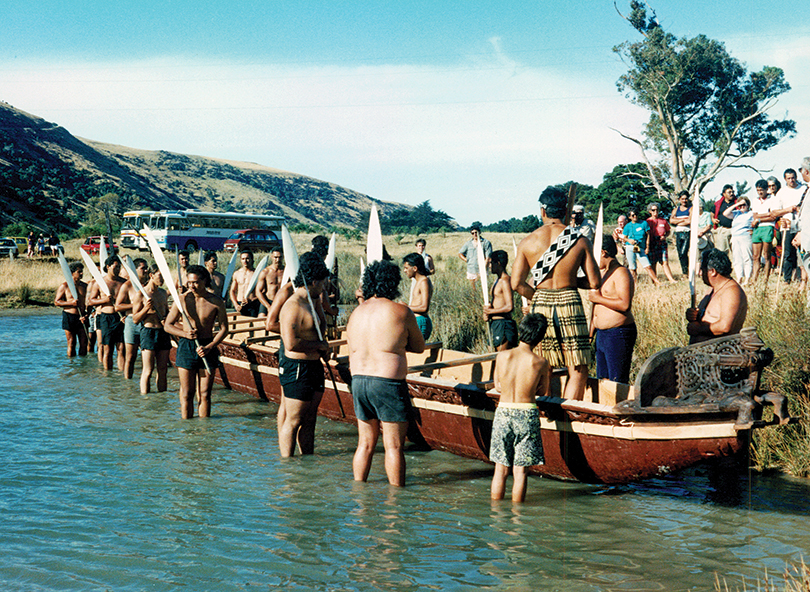
Above: Preparing to launch Kōtukumairangi, Waitangi Day, Okains Bay, 1990.
From the beginning Ngāi Tahu from Banks Peninsula, including members of the Robinson whānau, supported Murray. In the late 1960s, Toby Robinson arranged for a significant collection of family taonga to be handed over to the museum on permanent loan. This collection included an English officer’s sword presented to James Robinson Clough at the flag-raising ceremony demonstrating British sovereignty at Akaroa in 1840, and a huge oil portrait of George Robinson Clough, seated on a white horse, which hangs grandly in the Whare Taonga at the museum today. Both taonga were significantly damaged, and Murray paid for their restoration. James Robinson recalls that his father, Francie, was regularly at the museum on Saturdays throughout the 1970s helping Murray prepare the new museum for its opening.
The Okains Bay Māori and Colonial Museum was officially opened a year later on Waitangi Day 1977. The name of the museum and its inclusion of Māori representatives on the museum board reflected Murray [Thacker]’s bi-cultural vision which was then rare in the museum sector. At that time, 6 February had only recently become a nationwide official statutory holiday and Waitangi Day was not commemorated at any other comparable public event in Te Waipounamu.
As the museum began to take shape, Murray established significant relationships with several Māori from Te Ika-a-Māui, including master carver John Rua (Ngāi Tūhoe) and Maheno Honotapu (Ngāti Porou), whose respective carving and tukutuku skills saw the creation of the pātaka, Matuku-Rangi and the whare, Whakaata. The lead-up to founding the museum as a public entity coincided with the establishment of the Māori Affairs Trade Training schemes, which had brought an influx of young Māori men from the North Island to Christchurch. When Murray heard the Rehua Māori Apprentices’ Hostel was struggling to source tōtara for carvings in their wharenui, he donated a tree from his farm. This marked the beginning of a relationship between Murray and the trade trainees who went on to assist with projects such as the roofing of the museum’s whare taonga in 1976, and the rebuild of the Colonial Hall after it was gutted by fire in 1992. Later, under MACCESS schemes run by Pura Parata in the late 1980s and 1990s, Māori apprentices took up training placements at the museum, including the sesqui-centenary project to carve the waka Kōtukumairangi.
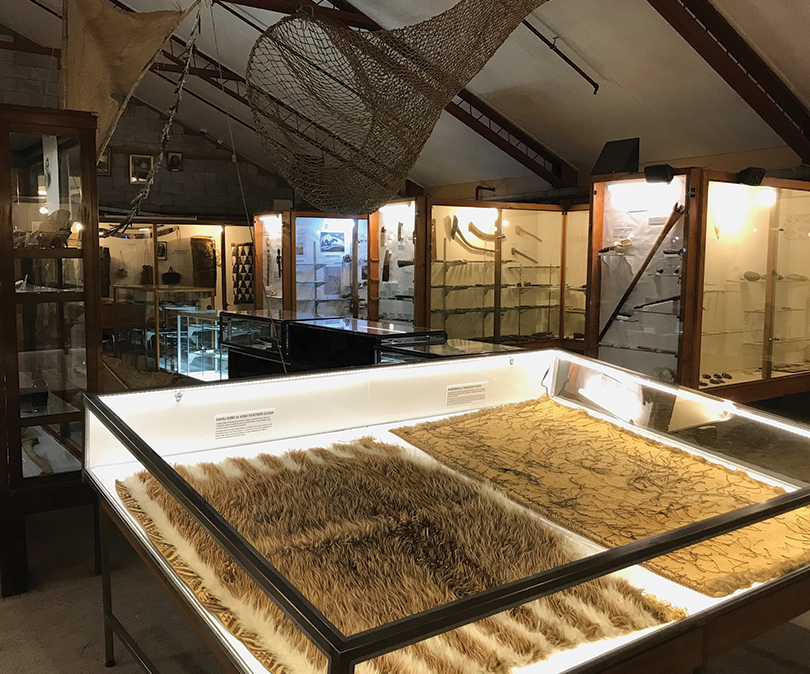
Above: Whare Taonga, Okains Bay Māori and Colonial Museum, 2019. The kāhu kiwi provenanced to Te Tai Poutini, is in the display case in the foreground.
In the mid-1970s Murray discussed commemorating Waitangi Day at the museum with Ngāi Tahu and Mātāwaka leaders, including Hori Brennan, Hohua Tutangaehe, Tip Manihera, Pani Manawatu, Poia Manahi, and Rakiihia Tau (snr). The first Waitangi Day commemoration was at the new museum site in 1976 when an open day raised funds to complete the museum buildings. The Okains Bay Māori and Colonial Museum was officially opened a year later on Waitangi Day 1977. The name of the museum and its inclusion of Māori representatives on the museum board reflected Murray’s bicultural vision which was then rare in the museum sector. At that time, 6 February had only recently become a nationwide official statutory holiday and Waitangi Day was not commemorated at any other comparable public event in Te Waipounamu. The opening included a pōwhiri to welcome the manuhiri, including a large contingent of Māori from the North Island’s East Coast. Aunty Jane Manahi was the kaikaranga and Francie Robinson was among the Ngāi Tahu manning the paepae. He was also the first Ngāi Tahu representative on the newly formed museum board, and kaiwhakatere of the waka, Kahukākā, which took to the water later that day. The inaugural 1977 event included live demonstrations, flag-raising, hāngī, and kapa haka, firmly establishing the template for all Waitangi Day commemorations in the bay since.
As the late Rakiihia Tau (snr) recalled, the commemorations at Okains were ground-breaking. He and others of his generation enthusiastically offered their support: “We had volunteer workers to assist this small community leading the way in New Zealand to recognise Waitangi Day … each year some of us would travel over to Okains Bay and welcome the public to the museum marae, address the principles of the Treaty, paddle the waka, and participate in activities designed to commemorate the Treaty of Waitangi and fundraise for the Okains Bay Museum.”
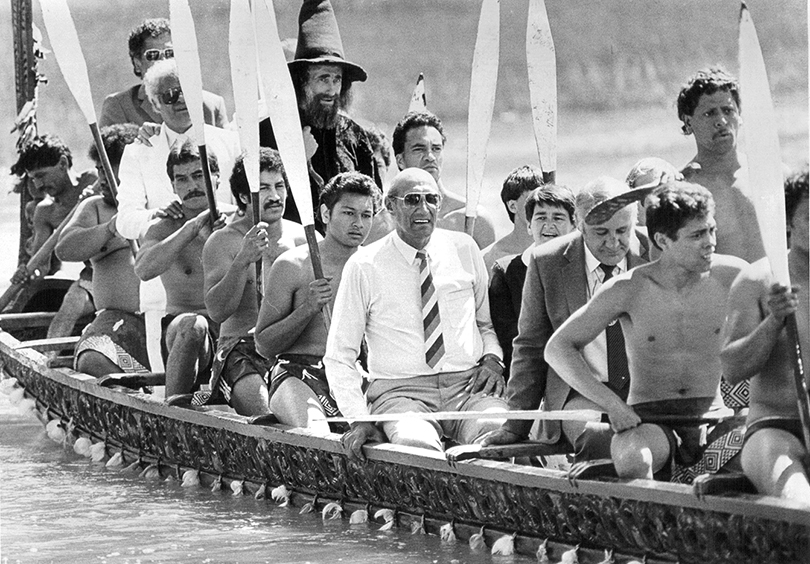
Above: Kahukākā on the Ōpara River, Waitangi Day, Okains Bay, 1987. Among the dignitaries in the waka are Ngaitahu Maori Trust Board Chairman, Tā Tipene O’Regan, Trust Board member Maurice Pohio, MP for Selwyn Ruth Richardson, the Wizard of Christchurch, and secretary of Ngā Hau e Whā Trust and the Governor-General’s representative, Hori Brennan.
Rakiihia, his contemporaries, and their families continued to provide support to the museum throughout the 1970s and 1980s. From the mid-1980s, with the progress of the Ngāi Tahu Claim before the Waitangi Tribunal, the Ngaitahu Maori Trust Board became a regular official presence at Okains. Tā Tipene O’Regan recalls that in this crucial period, the commemorations provided an ideal opportunity for Ngāi Tahu to “front foot publicly” on Waitangi Day and “educate the public that the Treaty was not limited to the Far North.”
Trust Board participation in the commemorations also guaranteed that “Ngāi Tahu would be front and centre rather than relegated to the side lines” by the media. While a representative of the Governor-General had attended the Okains Bay commemorations from 1978, in 1988, at the Ngaitahu Maori Trust Board’s invitation, Governor-General Sir Paul Reeves attended in person, signalling the political significance afforded by official Ngāi Tahu involvement. The Okains Bay event continued to provide an important political platform for Ngāi Tahu throughout the 1980s and 1990s. It also served as a forum for political protest groups calling for the Treaty to be honoured.
Charlie Crofts became involved with the commemorations from the late 1980s. He recalls Murray working with the Ngaitahu Maori Trust Board on various issues, including the construction of Kōtukumairangi. The idea to build a Ngāi Tahu waka to participate in the Waitangi Day commemorations was first proposed by Ngaitahu Maori Trust Board member Maurice Pohio. An agreement was reached and in May 1987 a tōtara was felled on Murray’s property and was attended by Ngāi Tahu kaumātua and Trust Board members. Two further tōtara were felled and work started on carving the waka in May 1988. In addition to providing tōtara, Murray accommodated the carvers and assisted them. Unfortunately, the group working on the waka were not experienced boat-builders, and on its initial launch during the sesqui-centenary commemorations in 1990 the waka proved unstable. James Robinson was among the paddlers on the ill-fated launch and one of the first to jump out as the waka “rolled precariously from side to side.” Murray spent the next decade rebuilding the waka, which was eventually successfully re-launched on Waitangi Day 2000 and then formally gifted to Te Rūnanga o Ngāi Tahu. Kōtukumairangi has continued to be a major focal point of Waitangi Day commemorations at Okains. It recently underwent extensive refurbishment ahead of a Tuia 250 flotilla event at Whakaraupō.
From 1996 official iwi-level representation at the Okains Bay commemorations ceased as Ngāi Tahu embarked on rotational hui at each of the papatipu marae closest to the three places where Ngāi Tahu rangatira signed Te Tiriti. Charlie Crofts says, “When we were building TRONT we decided we wanted to commemorate the Treaty at the places where our people signed.”
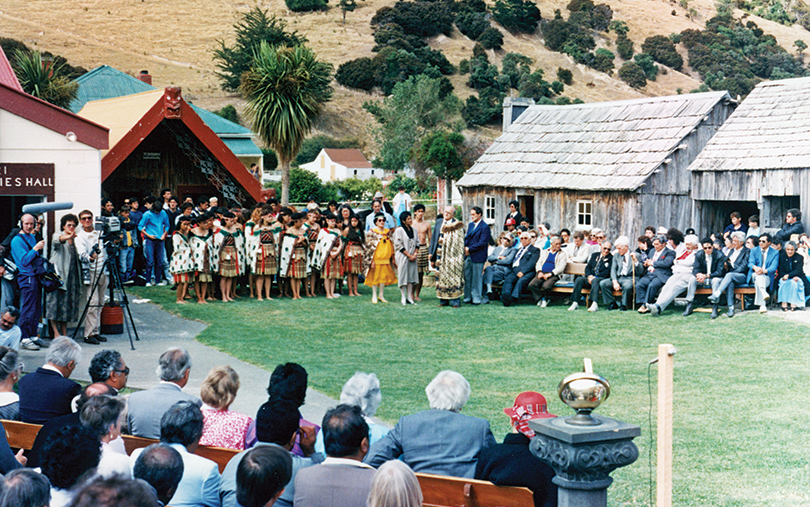
Above: Ngaitahu Maori Trust Board on the paepae, Waitangi Day, Okains Bay, 1988.
These events are hosted in turn by Ōnuku, Awarua and Ōtākou, providing important forums for reflecting on the place of Te Tiriti in our shared past, present and future. In the post-settlement era, Ngāi Tahu, and particularly mana whenua, Te Rūnanga o Koukourarata has continued to support the museum at a governance level and on Waitangi Days. In 1998, the reserve land opposite the museum (and at the beach) was returned to Ngāi Tahu under the Ngāi Tahu Claims Settlement Act, adding another layer of complexity to the ongoing relationship between Ngāi Tahu and the museum. While Ngāi Tahu is the fee simple owner of the land, legislation states that it must be managed as if it is a reserve, meaning that Ngāi Tahu has received no benefit from it since settlement. The museum-owned waka Kahukākā, and Kōtukumairangi are housed in a boat shed on the reserve, as is the whare, Tini Arapata. On Waitangi Day, the reserve is also the site where the hāngī is put down, under the watchful eye of Peter Ramsden.
“Not only are there Ngāti Huikai taonga [in the museum], but we are also the kaitiaki of taonga from all the other iwi. That puts us in a unique position of responsibility. It’s our whakapapa in there. It’s our knowledge and we are charged with protecting it. I’ve always felt that very personally.”
Peter Ramsden Koukourarata representative on the museum board and overseer of hāngī preparations on Waitangi Day for over 20 years
Peter has been the Koukourarata representative on the museum board and the overseer of hāngī preparations on Waitangi Day for over 20 years. He is stepping down this year and says the evolving relationship that Ngāi Tahu has had with the museum “reflects the progress of Ngāi Tahu on our journey.” For Peter, the museum collection has always been the driving factor behind his commitment to the place. “Not only are there Ngāti Huikai taonga there, but we are also the kaitiaki of taonga from all the other iwi. That puts us in a unique position of responsibility”, he says. “It’s our whakapapa in there. It’s our knowledge and we are charged with protecting it. I’ve always felt that very personally.” One of the stand-out taonga for Peter is a unique ‘tiki taniwha’ pendant from Koukourarata that was blown out of a post hole by a fencer in 1967. This taonga was selected to represent Koukourarata at the prestigious Mō Tātou: Ngāi Tahu Whānui exhibition at Te Papa Tongarewa from 2006 to 2009. Other taonga of significance to Ngāi Tahu include a hei tiki and a whakapakoko rākau (god stick) from Akaroa, and a magnificent partially-worked block of pounamu in the process of being cut into toki which was found at Pā Bay in the 1880s.
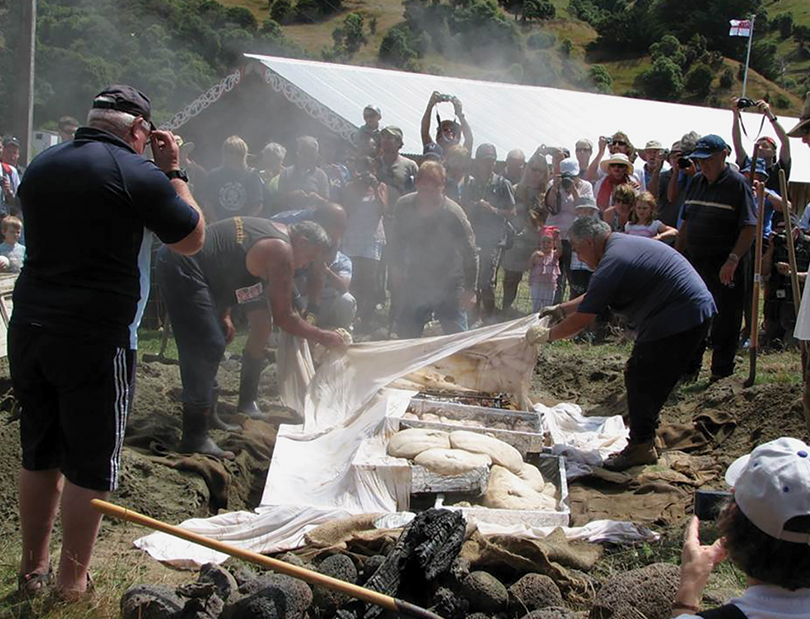
Above: Peter Ramsden and the crew lifting the hāngī, Waitangi Day, Okains Bay, 2018.
In 2016, Dougal Austin and Matiu Baker, from Te Papa Tongarewa, assessed the taonga Māori at Okains and concluded it is a “collection of national significance.” They noted that: “One would generally expect to find such a large, wide-ranging and comprehensive collection of such remarkable quality only in the main regional museums of New Zealand and in the national museum. The fact that such a collection has been created in a relatively remote rural locality is extraordinary and is testament to the considerable passion, determination, expertise and foresight of the museum’s founder.”
The relationship between Māori and museums has always been fraught and the Okains Bay Māori and Colonial Museum is no exception. The collection, display, and interpretation of taonga Māori is inherently problematic, particularly when this work is undertaken by non-Māori. However, the Okains Bay museum has a long history of working with Ngāi Tahu and, since settlement, has built a strong partnership with Te Rūnanga o Koukourarata. This year, the museum is embarking on a project to redevelop its Whare Taonga. Chair of the museum board, Nigel Hampton, says the project “presents a fantastic opportunity for us to improve the physical and cultural care of the collections, and to bring the taonga to life through story-telling.” Peter Ramsden is unequivocal: “The Whare Taonga has to be rebuilt and the stories of our taonga must be appropriately told. But the museum also has to be financially secure and supported in a way that befits the mana of the collection. It is unique among museums.”
Helen Brown (Ngāi Tahu) is Kairangahau Matua Tiaki Taonga (Senior Researcher Archives) in the Archives Team at Te Rūnanga o Ngāi Tahu. In 2015 Te Rūnanga o Ngāi Tahu appointed Helen as their representative on the Okains Bay Māori and Colonial Museum Board.